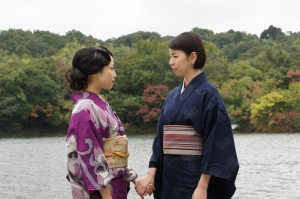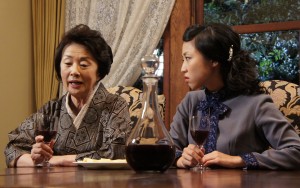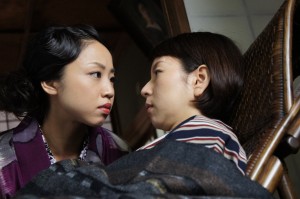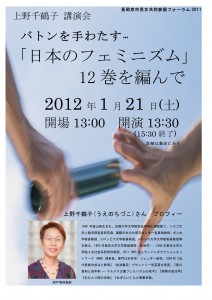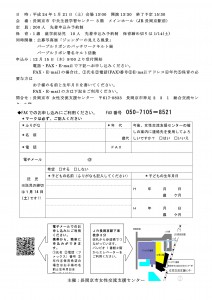There was a period of movement preventing violence against women between November 12 and 25, 2011. Nagoya city gender equality center enforces a project regarding prevention of violence against women(domestic violence) in November every year.
This year our NPO SANKAKU PLANET called Ms. Mieko Takenobu, a journalist and presently a professor of Wako University from Tokyo and had her talk about “ actual condition of women’s poverty from a point of view of domestic violence” on November 26, 2011. On the day, victims, supporters and those who were interested in domestic violence participated our event, while there were many events held by a variety of organization in Nagoya city. Some of them participated both this event and others. Therefore, we could have assumed that many people expected the event.
Ms. Takenobu asked “ Does a marriage help women from poverty ? ” in the first paragraph of her resume. While Ms. Takenobu conferred an article which she collected news data in 2008, she picked up an example which a women became poor by her marriage even though she had economic basis. Against a discourse like “girls had better get married”, Ms. Takenobu insisted that marriage does not complement women’s economic power like saying “ marriage with domestic violence will make women be poorer than before marriage and take women’s power to escape.
Continuously, Ms. Takenobu explained Japan is very severe environment for women to survive by using data regarding a high poverty rate of women in Japan and a gap of labor environment between men and women. Especially, we were shocked by the facts that “ only Turkey and Japan resulted that not-working single mother’s poverty rate is higher than working single mother’s”. In Japan livelifood protection is the only relief support for the people. Also, it is problem that women only rely on “home and husband” as safety-net. We have to recognize the actual condition that “Economic and social system on the premise of “husband” incur domestic violence, at the same time it obstruct women to get out from a house for escaping domestic violence” as Ms. Takenobu said.
Moreover, Ms. Takenobu put a question that the way of gender equality policy which does not consider poverty by pointing Equal Employment Opportunity Law (1985), a shrewd mechanism of between labor deregulation and welfare system. Ms. Takenobu considered that supporting policy for working women in Japan is not working by showing an example of Europe and said “ We have to regulate men’s working style if we say real gender equality”. Also, she brought up a chain of poverty which would improve in the future because women’s poverty is connected children’s poverty.
Ms. Takenobu’s talk which is substantiated by collecting news materials and data taught us that we have to take and consider the actual condition of Japan seriously. Actually, about various problems around women, especially domestic violence problem, we have a lot of things to solve.Then we sometime come to nothing. We assume there were many participants at the place might have felt such as “ Why Japan is such a condition ? ”, “ How can we do to the things better ? ” and irritated the things unchanged. However, Ms. Takenobu emphasized “ It is better to do something or to speak out. Do not think nothing is change. Let’s act even a little. Let’s make an appeal”. Domestic Violence Act is enacted by women’s act. We at the place received energy from Ms. Takenobu’s energetic cheering that we want to step forward with hope.
Original Article by NPO SANKAKU PLANET on the WAN Website (Dec. 24, 2011)
Translated and Adapted by Mariko. O






